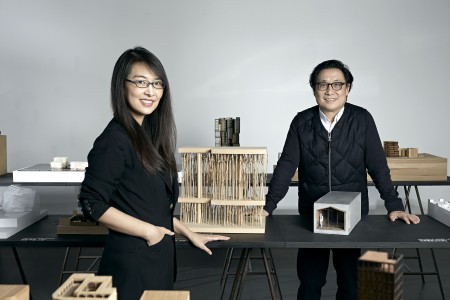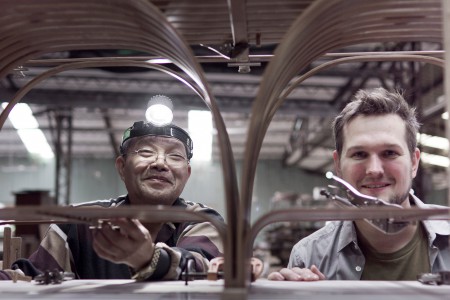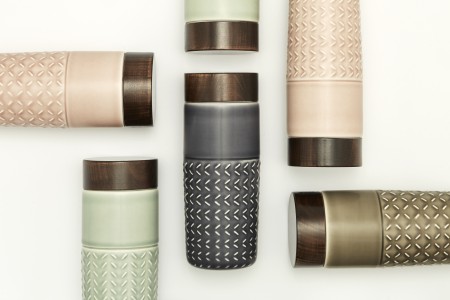Beatrice Hsieh Talks WDC2016: Taipei
Taipei’s new Commissioner of the Department of Cultural Affairs shares insights into what it takes to be a World Design Capital, in 2016 and beyond.
As any design aficionado knows, Taipei is the World Design Capital 2016. Besides the usual events, exhibitions, conferences, etc., the city has also affirmed its commitment to design with the appointment of Pei-Ni Beatrice Hsieh as the Commissioner of the Taipei Department of Cultural Affairs earlier this year. We had a chance to speak with the commissioner at this early point in her tenure.
In a highly discursive and enlightening conversation, Commissioner Hsieh spoke broadly about her background and experience as a curator, critic, professor, and now as a public official. Equally likely to quote Chinese proverbs and 20th-century Western philosophers, Commissioner Hsieh spoke knowledgeably about topics ranging from astrophysics to the Austronesian diaspora.
Amid the rapidly turning tide of a new administration in her native Taiwan, Hsieh was selected by Taipei City Mayor Ko Wen-je for her extensive international experience. Following her studies in Belgium, she subsequently worked in transitioning regions such as Eastern Europe and South Africa in the early 90s, later earning accolades from France, Italy, and the Czech Republic. All told, Commissioner Hsieh has previously worked in 400 cities in 40 countries.
Over the course of the conversation, she offered a measured assessment of the World Design Capital title, recognizing that it is not only a year in the spotlight but also an opportunity to plant the seeds for long-term goals that may take years or upwards of decades to achieve. Similarly, considering that Commissioner Hsieh officially took office in February this year — after much of the WDC programming was in various stages of development — she expresses gratitude to Mayor Ko for his support in developing “World Design Capital 2.0”. In this exclusive interview, she provides a thorough account of World Design Capital 2016: Taipei.
TLMag: First of all, congratulations on earning the World Design Capital honor for this year. Can you broadly speak about Taipei’s approach to this prestigious title?
Beatrice Hsieh: My extensive domestic and international experience in the fields of art and culture more broadly, as well as some direct experience in the design field, give me a particular insight into the cultural needs of a city, both for today and far into the future.By adopting World Design Capital 2016 as a platform, the City Government is now actively incorporating into the city administrative system the abundant innovative skills of local design professionals and creativity from the people of Taipei. Moreover, the city is forced to face anew the turning points and challenges in Taipei’s present development through design thinking; and by understanding the past, deal with the present and face the future, allowing Taipei to once again redefine itself and reestablish new values for the city under the World Design Capital 2016 core theme of “Adaptive City: Design in Motion”.
TLMag: As the “World Design Capital” title suggests, Taipei can compete with other cities on a global scale. In your own words, how would you characterize Taiwanese design?
BH: Taiwan is internationally famous for many things including food, night markets, and electronics. Aside from Taipei 101, design has never been at the forefront of what local people think of as “internationally famous in Taiwan”. Through the efforts of the Taipei City Government and the World Design Capital Taipei 2016, Taipei and Taiwanese design is in the world spotlight this year.
WDC events such as the International Design House Exhibition and the International Design Week Forum in October will highlight famous Taiwanese designers globally. Local students, designers, and studios are winning prizes and being recognised globally for international awards like the Golden Pin Design Award, iF, Industrial Design Excellence Awards, and Red Dot. This year, for example, young Taiwanese designers took home 10 of the 33 iF Public Value Student Awards.
Of course, we also assist Taiwanese designers to access events overseas. For example, in 2014, when the Taipei City Government organized an exhibition of local design at The London Design Festival, exhibition curator and renowned Taiwanese designer Chou Yujui (Kevin) (周育潤) portrayed a unique combination of bamboo craft techniques and design for his curatorial concept. In 2015, Taipei attended Design Days Dubai and encouraged the cooperation between Taiwanese designers and technologists. According to the Taipei City Government, the Taiwanese designer is also behind the design of the torch for the 2017 Universiade, which will be held in Taipei.
It is not just the combination of traditional and cultural design, but also developments in materials and design techniques that are being expanded into what is known as “Taiwan Design.” With all these efforts and the increasing recognition, “Taiwan Design” is now part of the local conversation of what is “internationally famous” and is something for the city of Taipei as well as all Taiwanese to take pride in. As the host city of WDC 2016, our theme is “Adaptive City – Design in Motion”. We expect that through creative thinking and a prolific and diversified approach to design, we will be able overcome the limitations posed on Taipei by a lack of resources and ensure that the management of and experiences within the city follow a distinctively Taiwanese, yet at the same time globally aware, design vision. We expect that Taipei will become a role model for other cities in Taiwan and possibly even, in time, for other cities in Asia and around the world.
TLMag: Tell us more about the theme, “Adaptive City: Design in Motion”. How does the programming reflect the current interest in design for social impact, and support this area of innovation?
BH: Interestingly enough, “Adaptive City” is the theme of Taipei’s story as World Design Capital 2016. It paints a picture of how a city with limited resources, when compared to other megacities (such as London, Tokyo, or New York) can still maintain innovative vitality and dynamism. International events as large as an Olympic Games or a World Cup have never been held in Taipei and yet, vast dynamic innovative capabilities still exist. In fact, the capacity to innovate is determined by the will of a city to pursue the well-being of its residents.
Since the announcement of the WDC bid in 2012, Taipei has been evolving as a city of design. With the help of Taiwan Design Centre and developing venues such as Songshan Cultural and Creative Park and Huashan 1914 Creative Park and Taipei Fine Arts Museum showcasing both domestic and international exhibitions, Taipei has improved its global perception as an international design hub. As World Design Capital in 2016, we are on a crescendo as a design city and are ready to share the story of our development with the world and will continue to nurture this level of innovative and creative thinking for the future.
Looking back on the course of Taipei’s development, although the city has limited resources, it still compares well with other cities around the globe in terms of competitiveness, and relies on the innovative ability of Taipei City’s administration. However, having advanced into the era of globalization of the 21st century, Taipei is now facing numerous unavoidable challenges: an aging population; a recessed economy; global warming and regular damage from natural disasters such as typhoons; and a lack of usable land space for housing and public facilities.
When considering these issues under the WDC Taipei 2016 banner, we have divided them into four core areas relevant to Taipei society as a whole: Life Quality and Health, Ecological Sustainability, Smart Living, and Urban Regeneration. In facing these problems through the lens of design, we are activating all of the adaptive strength and regenerative versatility of Taipei so the city can acclimate itself to the circumstantial changes it is facing today, and bring about transformation and creativity — through all design disciplines, and in a way that is sensitive to the diverse cultural backgrounds — to accommodate the needs of the city’s residents.
TLMag: How has the World Design Capital (WDC) Taipei 2016 program been going? What are the highlights so far? Can you share any interesting anecdotes or success stories from WDC Taipei 2016 thus far?
BH: The global recognition we are gaining in this WDC year will further inspire our design community. In order to ensure international visitors and residents alike get the utmost benefits from the WDC designation, we have prepared a plethora of interesting events in a year-long program. For example, since March, WDC Taipei 2016 has been hosting a number of exciting workshops and events for the Open Call program, which is an international project-funding program that pairs local and international design companies together to deal with social issues affecting through design.
WDC Taipei 2016 is also exposing the local public to international design through a number of international design exhibitions and residency programs. “Creative Roughness – Contemporary Israeli Design” runs from July to mid-August at Songshan Cultural and Creative Park and features the work of 45 Israeli designers. This month, the Designer in Residence program is bringing designers from the UK, the Netherlands, Germany, and Spain to participate in public events such as open studios, workshops, and forums, while also developing their personal design projects.
As for success stories, The theme of this year’s World Industrial Design Day was “Youth in Design,” which aimed to highlight the contributions of young designers. It also represents the new energy and future trends in the industrial design industry. In celebration of WIDD, WDC Taipei 2016 organized a series of seminars and workshops, including “The Square” created by emerging designers, and “Design-aholic” that invited Taiwanese designers from across disciplines; Japanese design giant GK Graphics was also invited to come to Taiwan and shared on experience in Japan, while Dutch and British design teams hosted workshops. The activities attracted participation by enthusiastic citizens.
Many citizens often ask what is WDC? What are its influences? In fact, the most important objective of WDC is to inspire younger designers and creative professionals to contemplate on the possibility of using design to change the city, and using design to tackle problems. This core concept coincidentally echoes WIDD’s 2016 theme of “Youth in Design.”
TLMag: Design education is a major factor in shaping the future of design, so it’s great to see that YODEX has been around for over three decades now. Can you tell us a bit more about this program?
BH: YODEX is the world’s largest student design exhibition. This year, the show featured graduation works by undergraduate students from 64 Taiwanese universities and colleges. Students from 13 international higher education institutions in Canada, the US, the UK, Japan, Australia, New Zealand, and Italy also participated in the exhibition, which was held in Halls 1 and 3 of the Taiwan World Trade Exhibition Center. During the awards ceremony on Sunday afternoon, 42 outstanding projects were honored by the Young Pin Design Awards.
Founded in 1982 by the Industrial Development Bureau and the Ministry of Economic Affairs, and organized this year by the Taiwan Design Center, YODEX provides a platform on which to stimulate constructive competition between students. This year’s event attracted thousands of visitors, giving entrants an opportunity to show off their graduation projects to an international audience as they prepare to embark on their careers.
As part of the World Design Capital (WDC) Taipei 2016 year-long program, YODEX was an opportunity to celebrate the innovation and creativity of the city’s students, and to reflect upon design’s potential to change society for the better. Embodying the WDC Taipei 2016 theme of “Adaptive City: Design in Motion”, students displayed works with a strong environmental and social awareness, ranging from earthquake escape kits and survival shelters to documentaries on sustainable ocean management.
TLMag: The WDC Taipei 2016 program also includes a number of international exhibitors. How have these presentations been received amongst the local design community?
BH: International programs such as the Open Call program the Designers in Residence project, as well as international exhibitions such as “Inside Heatherwick Studios” from the UK and “Creative Roughness” have not only provided Taipei City’s citizens exposure to high quality international design, but have also provided a chance for direct interaction and conversation. We hold many side events, such as workshops and forums, related to these international programs, and there is such enthusiasm from the local design community and the public that they are booked out in just days. Interest in design is blossoming in Taiwan, and people in the city are curious and interested in finding out what’s happening in the field in other parts of the world. We also try to ensure the activities we organize are varied: we have everything from hands-on workshops for children to large scale forums, and many are led by the international designers we have invited to participate in the numerous WDC Taipei 2016 programs. The events are also free. This ensures that every sector of society can have access to design that will appeal to and inspire them.
What forthcoming WDC Taipei 2016 events or activities can we look forward to?
BH: Design professionals and enthusiasts around the world should definitely look to visit Taipei in October, with four major World Design Capital Taipei 2016 events taking place. Three of the four International Signature Events — the International Design House Exhibition, International Design Week Forum, and International Design Policy Conference — are open to the public, and attendees can sign up to attend on the WDC Taipei 2016 website in August. The fourth event, the Network of Cities Meeting, is a closed event that will be attended by invited city representatives and urban design professionals from around the world. We will update the public as to the impactful international outcomes of the meeting as soon as it wraps up.
This interview has been edited for length and clarity.






